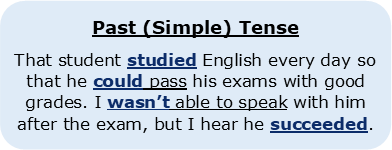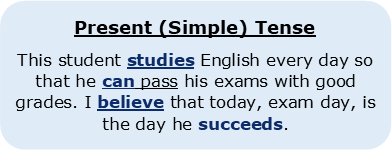Is verb aspect different to tense and modality?

This is the first of three chapters about Verb Aspect. To complete this reader, read each chapter carefully and then unlock and complete our materials to check your understanding.
– Introduce the concept of verb academic in English grammar
– Compare aspect with tense and modality and explore how these three functions may be combined
– Include examples of each feature to help guide the reader
Before you begin reading...
-
video and audio texts
-
knowledge checks and quizzes
-
skills practices, tasks and assignments
Chapter 1

Verbs have lots of useful (though sometimes complex) functions. These can be expressed by either changing the ending of a verb or by adding new verbs to the verb phrase. One of the most common functions in academic English relates to the expression of time – whether it’s the past, the present or the future. Because students often make mistakes with expressing fixed time and periods of time, particularly when writing essays and dissertations, this short reader attempts to address some of these issues, focussing specifically on the expression of aspect.
In Chapter 1, we first compare verb aspect with verb tense and verb modality. Then in Chapter 2, we explore the four English aspects (simple, progressive, perfect and perfect progressive) before applying their 12 combinations in Chapter 3 to general and academic settings. After completing this short reader, don’t forget to unlock and complete our chapter worksheets as you can use these to check your understanding and progress and improve your overall English proficiency.
What is a verb’s aspect?
Before we compare aspect with tense and modality, it’s important that we first explore what verb aspect is and how it’s formed. Start off by studying the following two examples which use the progressive and perfect aspects:


What you should hopefully have noticed in these diagrams is that aspect expresses periods of time or time relations. You may also have noticed that aspect is expressed in English by making changes to the main verb or by adding new verbs to the verb phrase. This can be expressed in four aspects: simple (‘learns’), progressive (‘is learning’), perfect (‘has learned’) and perfect progressive (‘has been learning’).
How is aspect different to tense?
Did you also notice that the progressive and perfect aspects were combined with the present and past tenses in the last diagrams to create the ‘present progressive’ and ‘past perfect’? While aspect is used to show periods of time or time relations, tense expresses fixed positions in time such as the past, the present or the future. While aspect and tense time functions are somewhat inseparable, it’s important to recognise that they function quite differently. As the following two examples show for the past and present, the ‘simple’ is the singular default aspect that doesn’t express periods of time and only shows the fixed time of its associated tense:


How do we express the future in English?
What you may also be interested to know is that only the past and present are considered to be true tenses in English and not the future. This is because grammarians argue that (unlike aspect) tense can only be shown by making changes to the form of a verb. While other languages such as Spanish or French may express the future through the addition of suffixes to their verbs (and as such are said to have a future tense), in English we must add a modal verb such as ‘will’ or ‘may’ to the verb phrase in a process called verb modality:

It is only by adding these modal verbs to the verb phrase that we are able to express future events, possibilities and hypotheticals in the English language.
What are the 12 tense, aspect and modality combinations?
The reason it’s important to also distinguish verb aspect and tense from modality is because each of these three verb functions possesses different rules, forms and uses. What’s more, aspect, tense and modality can all be combined to create twelve different patterns in English. Knowing how to combine these functions into twelve patterns with accuracy and how to use them effectively is a critical part of mastering both general and academic English:


Students should note that it may be common to hear of all twelve of these patterns being described as tenses, meaning that English has twelve tenses in total. However, as we’ve explained, there are only two tenses in English (past and present) but twelve combinations of tense, aspect and modality.
Good work on completing this first chapter in our reader on verb aspect which has identified the main differences between aspect, tense and modality. In Chapter 2, we focus much more specifically on aspect and how to form, recognise and use it, so keep reading if you’d like to know more.
Downloadables
Once you’ve completed all three chapters in this short reader about Verb Aspect, you might then wish to download our Chapter Worksheets to check your progress or print for your students. These professional PDF worksheets can be easily accessed for only a few Academic Marks.
Chapter 1 explores the topic: Is verb aspect different to tense and modality? Our Chapter 1 Worksheet (containing guidance, activities and answer keys) can be accessed here at the click of a button.
Chapter 2 explores the topic: What are simple, progressive and perfect aspects? Our Chapter 2 Worksheet (containing guidance, activities and answer keys) can be accessed here at the click of a button.
Chapter 3 explores the topic: Are the 12 aspect combinations helpful for EAP? Our Chapter 3 Worksheet (containing guidance, activities and answer keys) can be accessed here at the click of a button.
To save yourself 2 Marks, click on the button below to gain unlimited access to all of our Verb Aspect Chapter Worksheets. This All-in-1 Pack includes every chapter, activity and answer key related to this topic in one handy and professional PDF.
Collect Academic Marks
-
100 Marks for joining
-
25 Marks for daily e-learning
-
100-200 for feedback/testimonials
-
100-500 for referring your colleages/friends